Overview
Context
Since the beginning of 2015, we have met with the HSE leadership team along with a number of other key stakeholders and programmes (e.g. NCCP). The purpose of these meetings was to understand the priority business or care capabilities that are essential to the delivering on the overall reform agenda of the HSE.
While the discussion and outputs consider priorities from a business/care capabilities perspective, the focus is on those that require technology enablement to be delivered. The outputs from this process are summarised below. These include a summary level description of key capabilities needs as well as a heat map of priorities specific to each division. This heat-map was constructed using an industry standard model for describing healthcare system capabilities.
The overall Knowledge & Information Strategy contains a consolidated view of priorities across the system. The format of this view / industry model has been adapted to be more tailored to the HSE and the purposes of the strategy. Specific changes from the input heat-maps below include:
- The view has been simplified by removing capabilities which no division regarded as a priority
- Capabilities have been reorganised into a more easily understandable structure
- Some capabilities have been decomposed, others consolidated to reflect granularity of the capability needs shared with us
- Some capabilities have been renamed to provide greater clarity and to make the priorities easily understandable to a broad audience
The ultimate purpose of this document is to provide a high level appreciation of the scale and nature of the capabilities to be developed.
Key points of note:
- The summary descriptions provided in the main points to note are high level only. Further details of our understanding of each capability have been documented and shared with the divisional lead
- The heat map represents “to-be” desired capabilities only. It does not represent existing capabilities that have already been implemented
- The relative heat shown in the diagrams below is approximate and only intended to give a general sense of where priorities lie
- Precise prioritisation will be undertaken as part of the demand management/portfolio management processes being introduced being introduced within K&I
Acute Services
|
Capability Priorities
|
Main Points to Note
|
|
Business Information Dashboards
|
- Depicting a Balanced Scorecard picture in real time and incorporating a predictive tool to aid overall hospital management, to include:
Finance (e.g. monitoring agency spend)
HR (e.g. including European Working Time Directive monitoring)
Quality/Safety
Patient Flow
- Put in place the high level capability and then mature the underlying data
|
|
IHI to enable data sharing and flow
|
- Building block for enabling other applications and programmes
- Not just about integrated programmes, but the substantial flow for other patient types that fall outside of these priorities
- Identifier is required
|
|
Managing patient flow within Acutes
|
- Need to manage delayed discharges
- Capabilities such as bed capacity predictive tooling based
- A need for eReferrals
- A better mechanism for the scheduling of OPD and Operating Theatres
|
|
Activity Based Funding
|
- Will require understanding of all activities relating to the treatment of that patient
- Requires an understanding of the costs underpinning each activity.
|
|
Other Finance
|
- Insurer billing capabilities will allow the hospitals to maximise funds recouped.
- Investing in Inventory control and management typically has a proven business case to realise benefits
|
|
Provider Performance Management
|
- Capabilities to compare providers in terms of key metrics (e.g. cost, quality, outcomes)
|
|
Delivery Considerations
|
Main Points to Note
|
|
Investment will be key
|
- Spending too little overall compared to other hospital systems
- Need to ensure that there are sufficient terminals and maximise the use of mobile devices use to drive adoption
- Need an implementation partner to assist, as there is a clear difference between implementation and installation
|
|
Business Involvement
|
- Immense interest, particularly among Gen Y clinicians, and technologies like mobile will be key to driving interest and adoption
- Will require significant spend to backfill the number of clinicians and other staff required for projects
- Need to identify clinical champions to drive adoption
|
|
Change Management Capability
|
- Doesn’t feel there are change management skills (training, process design, communications) currently. Decision needs to be made regarding where those skills will be developed and sit
- Don’t underestimate need for culture and behaviour change due to culture of inertia
- Needs to be proper process redesign and mapping – don’t just replicate the paper
|
|
Public/Potential Engagement
|
- The value of patient portals are often overestimated in terms of care outcomes, but they do help to demonstrate enhancements to the public and increase buy-in for investment
- Feels strongly that approach should be opt-out (typically gets 95% acceptance) rather than opt-in (typically 60-65% acceptance)
- Prioritise pushing out through GPs first with patient capabilities when more mature
|
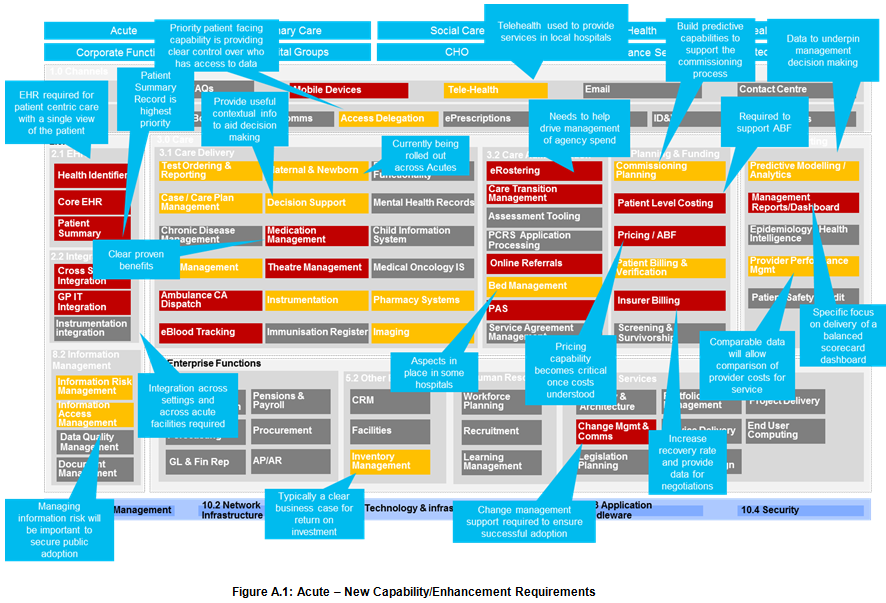
Clinical Programmes and Strategy
|
Capability Priorities
|
Main Points to Note
|
|
Money Follows the Patient
|
- A risk to the delivery of the Integrated Clinical Care programmes is that funding and incentives are still aligned with divisional priorities rather than integrated patient centric experience
- Until the necessary capabilities can be put in place to enable a money follows the patient model, financial incentives will not align with the to-be model of care impeding progress
- Substantial effort is envisaged to implement this change
|
|
Data Analysis
|
- Assessing the success and refining the ICPs requires strong data and KPIs to measure impacts. Implementation of IHIs is first step in this
- Operational units need to be accountable for data quality
- Ongoing data collection must be systemised
- Data collection efforts to be prioritised with a focus on measuring patient outcomes rather than feeding research data
|
|
Priority Clinical Programmes
|
- Implementation of a number of priority programmes will require technology enablement:
- Developing a framework to establish Major Trauma Networks
- Opportunity to develop a TARN/UKROC type programme with the National Rehabilitation Centre to measure long term outcome after serious trauma
- Implement frail and elderly pathways
|
|
Chronic Disease
|
- Priority to expand already successful pilot programmes.
- Systemised data is critical to scale these programmes
- Disease registries
|
|
Telehealth
|
- Increase utilisation of Telehealth that is already in place.
- Roll-out ECHO community-based healthcare methodologies. Telehealth can assist learning for clinicians
|
|
Delivery Considerations
|
Main Points to Note
|
|
Clinical Design Authority
|
- Establish a Clinical Design Authority to ensure integrated thinking in relation to clinical process design
- Should align with business process design authority to be established for broader reform
|
|
Partner with Professional Bodies
|
- Continue to partner with professional bodies as the preferred means of engagement with clinical community
- Utilise these to improve buy-in to reform, secure necessary expertise for design and reach clinicians outside of HSE care settings
|
|
KPI Driven
|
- Drive planning and assessment of integrated programmes through KPIs
- Provide support to help implement collection and analysis of data as well as design of relevant KPIs that encourage appropriate behaviours
|
|
Authority & Accountability
|
- Appropriate authority to be delegated to programme leads to implement change in care settings
- Encourage long term buy-in and accountability by aligning funding models with ICP objectives and outcomes
|
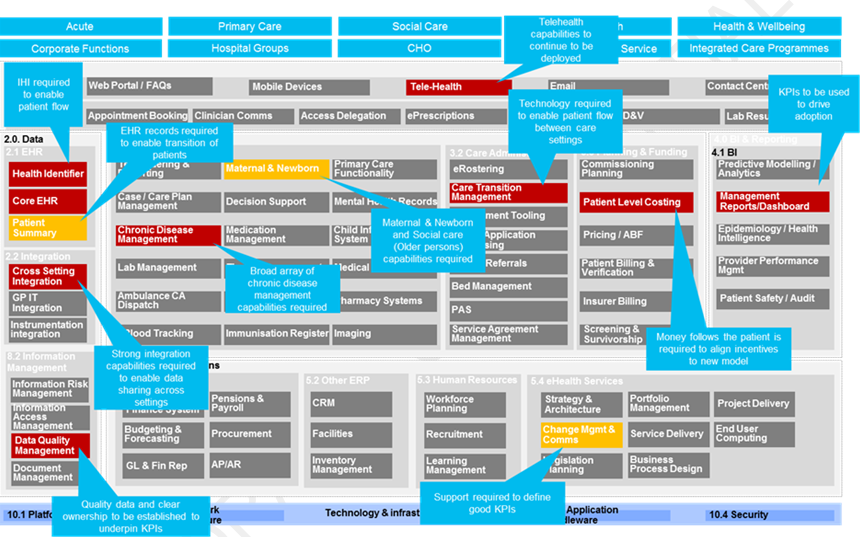
Finance
|
Delivery Considerations
|
Main Points to Note
|
|
Malleability
|
- Key pending decisions regarding future structures of the service present a risk with investing in new finance capabilities
- Any future finance capabilities, including the IFS, should prioritise malleability to facilitate immediate and future changes. This malleability should minimise effort, risk and cost to change.
|
|
Data Governance
|
- Criticality of information will require robust internal data governance framework to be put in place.
- Inconsistencies in data result in poor reporting and poor understanding of cost. This should be a key underpinning of any investment in finance systems
|
|
Strategic/Tactical Balance
|
- Resources are required to address tactical issues and immediate commitments
- Additionally, given the ambitions of the IFS, ABF and Finance operating model a surge of project management and change capabilities is needed to implement these aspects of the reform
|
|
Delivery Considerations
|
Main Points to Note
|
|
Malleability
|
- Key pending decisions regarding future structures of the service present a risk with investing in new finance capabilities
- Any future finance capabilities, including the IFS, should prioritise malleability to facilitate immediate and future changes. This malleability should minimise effort, risk and cost to change.
|
|
Data Governance
|
- Criticality of information will require robust internal data governance framework to be put in place.
- Inconsistencies in data result in poor reporting and poor understanding of cost. This should be a key underpinning of any investment in finance systems
|
|
Strategic/Tactical Balance
|
- Resources are required to address tactical issues and immediate commitments
- Additionally, given the ambitions of the IFS, ABF and Finance operating model a surge of project management and change capabilities is needed to implement these aspects of the reform
|
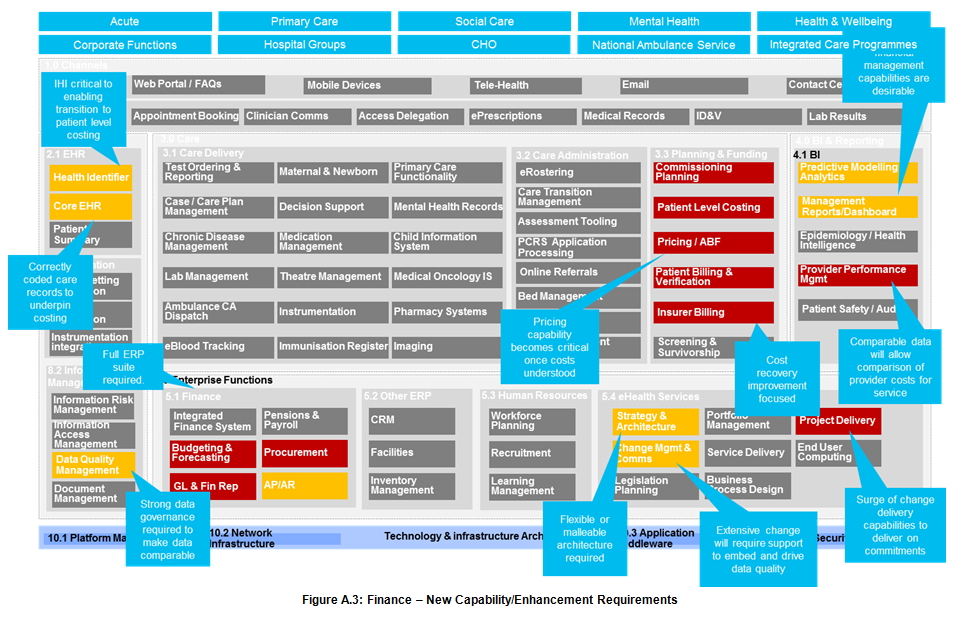
Health Business Services/strong
|
Capability Priorities
|
Main Points to Note
|
|
Rapidly Deployable CRM/Workflow/Case Systems
|
- Rapidly deployable platform to fulfil demand for case management/workflow
- A single platform/technology should be identified (e.g. dynamics CRM)
- Move simple forms leverage workflow similar to procurement pilot
|
|
Self Service Capabilities
|
- Minimise manual intervention, increase service speed, maximise quality
- Example priority areas include: Procurement, Estates, HR
|
|
IFS
|
- Implementation of a single Integrated Finance System
- Enable cost management by allowing drill down to transactional level
|
|
Procurement
|
- Complete the roll out of PASS and PPMS
- Tactical measures such as SAP adaptation for National Distribution Centre
- Implement invoice capturing solution and plan electronic tendering process
|
|
Productivity enablement
|
- Complete roll-out of HR document management system
- Implement proposed technology solution for estates (incl. Document Management)
- Online application forms that interface with dynamics CRM recruitment
|
|
BI
|
- Tools to interrogate and analyse rich data held by HBS
- Support workflow planning through analysis of recruitment outcomes
- Procurement: the piloted data warehouse solution should be extended to provide visibility of spend across the service
|
|
Other Finance Initiatives
|
- Progress the business case for a consolidated payroll system in parallel to a review and transformation of current payroll processes
- Creating single National Pension system for HSE staff and implementation of travel and subsistence management capabilities
- Complete the roll out of Claim sure in 2015
|
|
Delivery Considerations
|
Main Points to Note
|
|
Greater Focus on Enabling Capabilities
|
- HBS capabilities underpin success across the rest of the organisation and require greater future focus
- The €13b scale of the organisation requires robust supports and provides ample ground for strong business cases
- Business cases for investment in this space can be more clearly articulated in terms of impact on care services
|
|
Heavily Scaled IT Capability
|
- There are significant resources constraints and a need for additional IT delivery resources who understand the business context
- Resources will be required for committed projects, assisting with the form programme and ongoing BAU tasks
|
|
Business Transformation Capability
|
- Commitment required from the business to contribute resources to ensure projects are successful
- Specifically work to ensure that the gains are delivered before the gains are shared
|
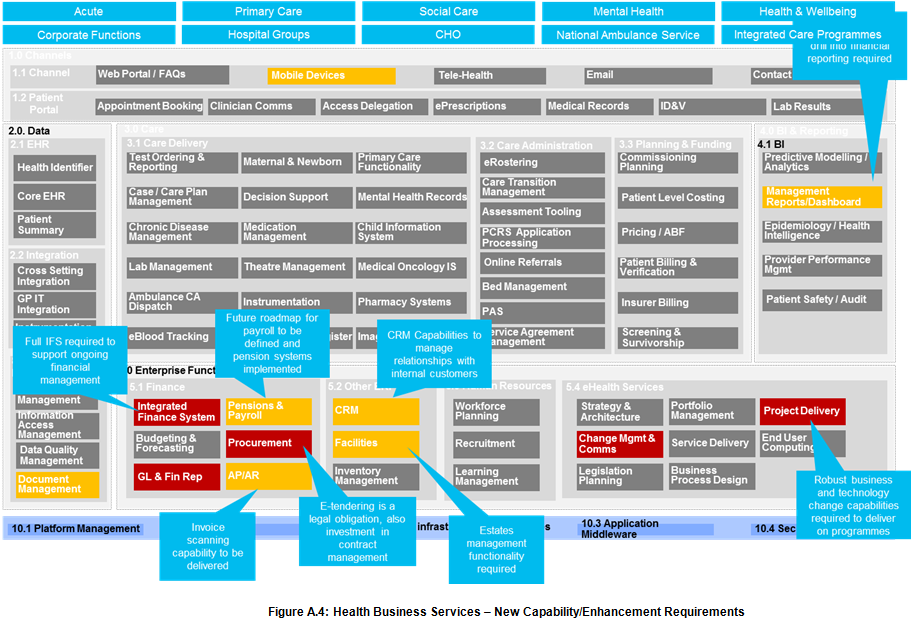
Health & Wellbeing
|
Capability Priorities
|
Main Points to Note
|
|
Data Capture
|
- Implementation of EHR systems are critical to ensuring that sufficient data is captured and consistency is brought to the quality of data
- Priority EHR programme is the implementation of a National Immunisation and Childhealth Information System
|
|
Data Linking
|
- The successful implementation of an IHI is critical to linking data for health intelligence purposes
|
|
Data Usability
|
- Health Atlas is a key platform to enable users across the health system to use data to drive decision making. Including further data sets and making the system accessible to a greater number of users is key
- Provide the predictive capabilities to support the commissioning process
- Robust knowledge management capabilities, to more fully utilise existing data
|
|
Self-Care
|
- A self-care framework is currently being developed
|
|
Chronic Disease Management
|
- There is a need to be able to assess the level of chronic conditions
- There is a need to develop a standard model of care for chronic diseases
|
|
Case Management
|
- A patient management system for managing smoking cessation cases is required
|
|
Delivery Considerations
|
Main Points to Note
|
|
Planning Assistance
|
- Some projects with merit have not been initiated due to insufficient understanding of the necessary process, timelines etc. Assistance for business units by “account handlers” would be desirable.
- Project management muscle is required to facilitate the creation of business cases and drive projects
|
|
Information Governance
|
- Criticality of information will require robust internal information governance to be put in place.
- Additionally there may be legislative requirements that should be planned for to enable effective use and sharing of data collected
|
|
User Focus
|
- Heavy business and end user involvement in the design phase of solutions
- Adopt an iterative approach that allows solutions to evolve for greater usability
- Finally, capabilities that support looking after staff are key if the overall service and projects are to be successful
|
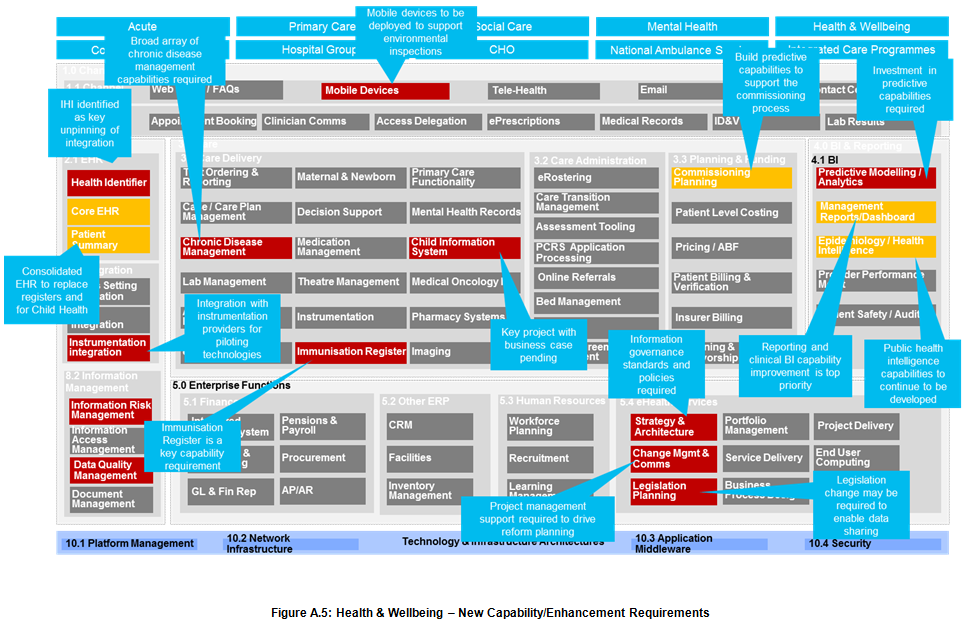
Mental Health
|
Capability Priorities
|
Main Points to Note
|
|
Basic IT infrastructure
|
- Currently care deliverers have no systematic /standard IT provision (e.g. laptop) – some do have these but this is on an ad hoc basis
- Basic enablement is required to support the adoption and use of future ‘business’ applications – laptops, secure access to HSE network, email
- As a quick win there is an opportunity to consider use of 3G enabled mobile devices to support some basic / limited functionality – e.g. meeting notes
|
|
Information management and MI
|
- The creation of a common data dictionary and a minimum suite of standard operational (non-clinical) procedures. Standardised (clinical) care pathways will also support this "systemisation of information"
- Basic systemisation of information is required for both care delivery and management purposes – e.g. to provide appointments scheduling, care notes, diagnostics, treatments, incident alerts & reporting, medication, appointment attendance – e.g.:
- Client meetings notes are recorded on paper and then transcribed into electronic format (more often than not transcription never happens in some CMHTs) – often a material time delay, which may lead to a risk of missing a crucial window for care intervention
- No aggregated MI exists to support more centralised coherent planning of resources and the wider decision support capacity
|
|
Patient medical record
|
- Systemised capability to capture patient care delivery, history is required to allow transition of care between different people in the team and into out-of-hours care provision
- Mental care would benefit from seeing a holistic view of all health care received by the client (e.g. attendance at an ED may indicate self-harm) but sensitivities apply in sharing mental care information with areas of care
- Currently no centralised view of care delivery for the client is available
|
|
Patient portal
|
- To provide an information and access point for client and a potential clients for mental health services, a mental health portal is required
|
|
Mobile capabilities
|
- Due to its highly dispersed nature and lack of ICT infrastructure backbone, mental health would benefit materially from mobile applications and a mobile enabled infrastructure for service delivery in the community and to support day-to-day care management – e.g.:
- Care notes keyed directly into an app and stored in a central database (supporting aggregated MI)
- Mobile diary management / scheduling of appointments / referral request and acceptance / patient reminders and attendance tracking
- Mobile incident alerts and reporting
- Access to historical patient record
|
|
Tele-health capabilities
|
- To support the need for more 24x7 care delivery, tele-health care solutions e.g. therapy via contact centre, or a regional on-call support and monitoring, would provide a way to extend coverage
- A pre-requisite for support beyond a passive ‘help-line’ type care would be the availability of a medical record, so that continuity of treatment between local and remote care is facilitated
|
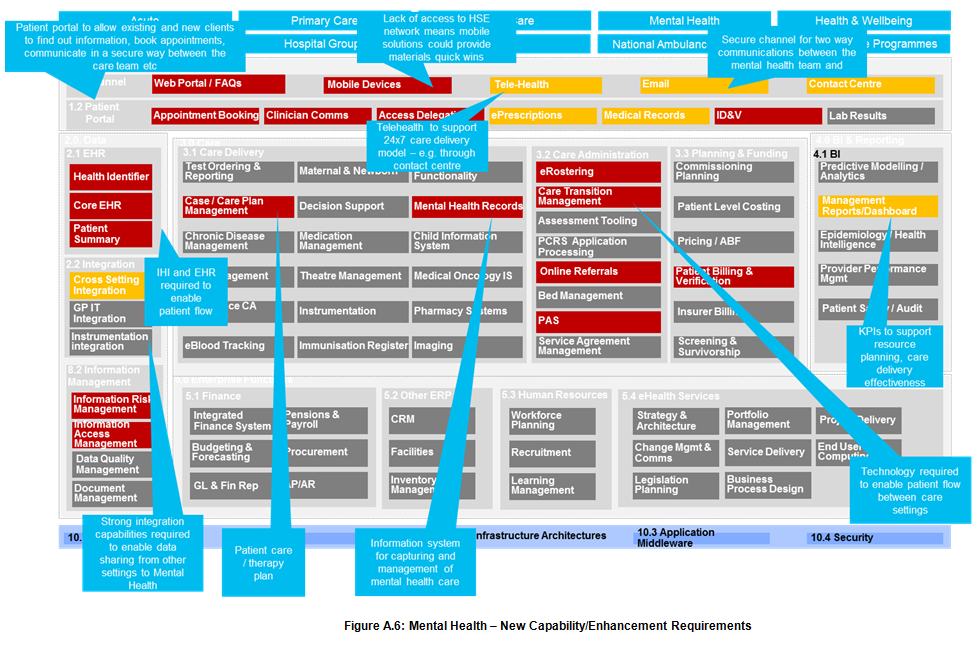
National Cancer Control Programme
|
Capability Priorities
|
Main Points to Note
|
|
Improving Data Management
|
- The creation of a datamart to store information to enable the complete collection of data and information from disparate sources to effectively assess outcomes and plan services. Data sources include cancer screening data, cancer treatment data, HIPE and BIU data, PCRS data). (Currently in progress with Health Atlas)
- Dashboards to display the datamart information in a succinct manner for Hospitals and NCCP
- Electronic data will enable research and clinical trials
|
|
eHealth requirements
|
- Each hospital to have a Medical Oncology Clinical Information System in place with interoperability to the national EPR (typical generic EHR systems don’t provide the required functionality)
- Integrated patient records across multiple systems and locations eliminating paper based records
- Multi-disciplinary team meeting systems to support data collection for KPIs and implementation of best practice guidelines
- Enable better communication of patient information to GPs and pharmacies for systemic anticancer therapy
- Patient access to medical records
|
|
Survivorship
|
- Patient self-management and access to complete medical history to support the discharge of cancer survivors to primary care
- Systems to enable follow up of patients following discharge as cancer survivors or to update treatment in line with emerging evidence
|
Note: Given the focussed nature of the NCCP – no overall heat map exists but priorities are reflected in the overall summarised system wide map included in the strategy
|
Delivery Considerations
|
Main Points to Note
|
|
Data Collation
|
- There is work underway to define minimum common datasets for collection to overcome the current data gaps when assessing outcomes. Discussions are ongoing by the HSE with NHS England to utilise these datasets
|
|
Approval Process
|
- The DOH/HSE process for the approval of ICT projects is in a state of flux, this requires clarification (re-establish a definite timeline for the Medical Oncology project that has been put on hold)
|
|
Clinician Support
|
- Maintaining the current support and buy-in from oncology clinicians by delivering on promises e.g. for a new Medical Oncology Information System
|
Primary Care
|
Capability Priorities
|
Main Points to Note
|
|
Patient Data Sharing
|
- Availability of electronic medical records underpinned by an IHI to enable continuity of care.
- A patient portal enables patients to be custodians of their own data
|
|
Complementary Functionality for GP Systems
|
- Build on existing GP IT systems with PAS like functionality
- Build on secure communication functionality to enable flow information between all parties
- Additional functionality requirements to enhance integration across hospitals and diagnostic systems
|
|
Patient Quality & Safety
|
- Extended use of electronic records can underpin data extracts and audit reports to demonstrate compliance and standards.
|
|
Electronic Case notes
|
- Productivity dividend to be had by moving away from paper-based case notes and time consuming duplication
|
|
PCRS application assessment
|
- Current entitlement application process is being reviewed as part of the broader reform to provide a more user friendly service
|
|
Patient Empowerment & Self Care
|
- An ICT platform that enables remote monitoring and management that will support both patients and clinicians in moving chronic disease management to the Primary Care
|
|
Delivery Considerations
|
Main Points to Note
|
|
Build on what we have
|
- Building a platform on top of the current GP platform and integrating with the existing GP platform to increase GP buy-in
- IT system relationship is directly between GPs and the vendor and should remain as such
|
|
Clinician Involvement
|
- The ICGP will become a more important player in the future so aim is to leverage the current good working relationship with the ICGP.
- Their involvement will need to scale along with the pace of change
|
|
User Experience
|
- Prioritise having a sleek, user-friendly design for so that the user experience incentivises adoption
- Involve a working group of clinicians in the design of the new GP IT system to ensure front line focussed design
|
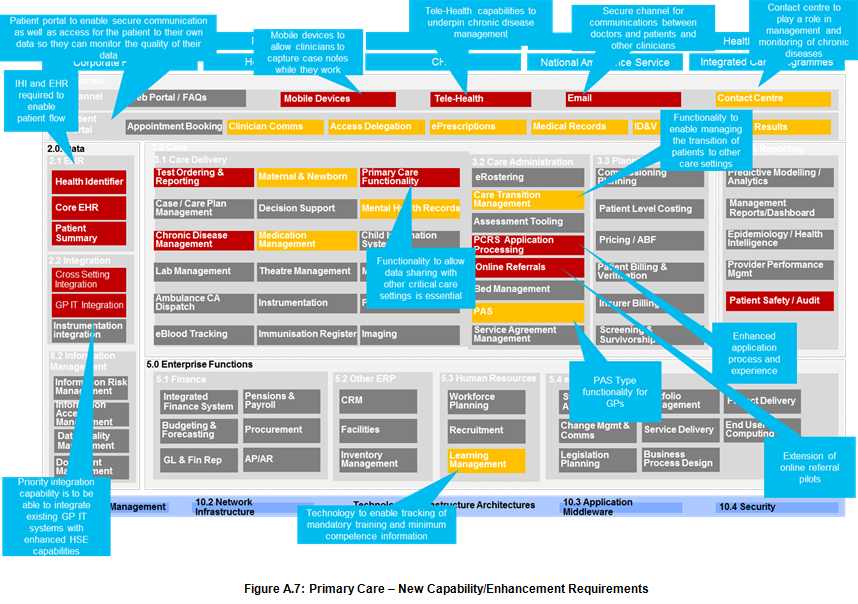
Social Care
|
Capability Priorities
|
Main Points to Note
|
|
Care Provision
|
- Robust needs assessment tooling is the key technology capability for care provision.
- Implementation of EHR is also a priority
|
|
Choice Enablement
|
- Implementation of EHR is also a priority
- A second key underpinning of choice is individual budgeting, which is effectively MFP in the Social Care setting.
|
|
Service Planning
|
- Service arrangement management capability is critical due to the number of voluntary providers
- Commissioning capability is a key priority
|
|
Integration
|
- The successful implementation of an IHI is critical to enabling integration
- Data integration between care settings is critical
- Greater integration within the care setting also remains a priority.
|
|
Business Process Standardisation
|
- There is substantial differences in processes within social care
- Business process re-engineering capabilities are required to be able to undertake standardising these.
|
|
Reporting
|
- Links between data is key
|
|
Delivery Considerations
|
Main Points to Note
|
|
ICP Alignment
|
- Delivery of the Integrated Care Programmes is a major priority, in particular the Older Persons ICP in the case of community care
|
|
Phasing of Delivery
|
- Successful projects in the past have involved a rapid targeted roll-out of a pilot solution in a specific locality. Using that area to build out the template processes and prove the benefits and then deploy both the processes and technology to other areas
- While a long term vision is needed, the phasing needs to be structured so there are clear milestones that deliver “chunks” of meaningful capability with measurable benefits
|
|
Centralisation vs. Divisional Balance
|
- While there is agreement that a long term vision should be pursued, this should not be at the expense of continuing to invest in tactical improvements that can also make a big difference in the short term. Some of these will provide quick wins.
- A clear vision and plan for the central programme should be established over a long period of time so that divisions are then free to, and informed sufficiently, to make decisions regarding where to invest themselves in their own tactical solutions
|
|
Delivery Challenges
|
- Limited ICT capacity has constrained what the divisions can undertake. The general view is that the focus should remain on an achievable number of projects that are managed by HSE but delivery is outsourced
- Successful delivery of projects requires both greater business process and project management skills that can be deployed to the divisions to either assist them with their own projects or support the design and embedding of broader centrally led initiatives
- Previous projects have encountered challenges relating to issues such as data protection/legislation. Capacity and capability to deal with these issues are required.
|
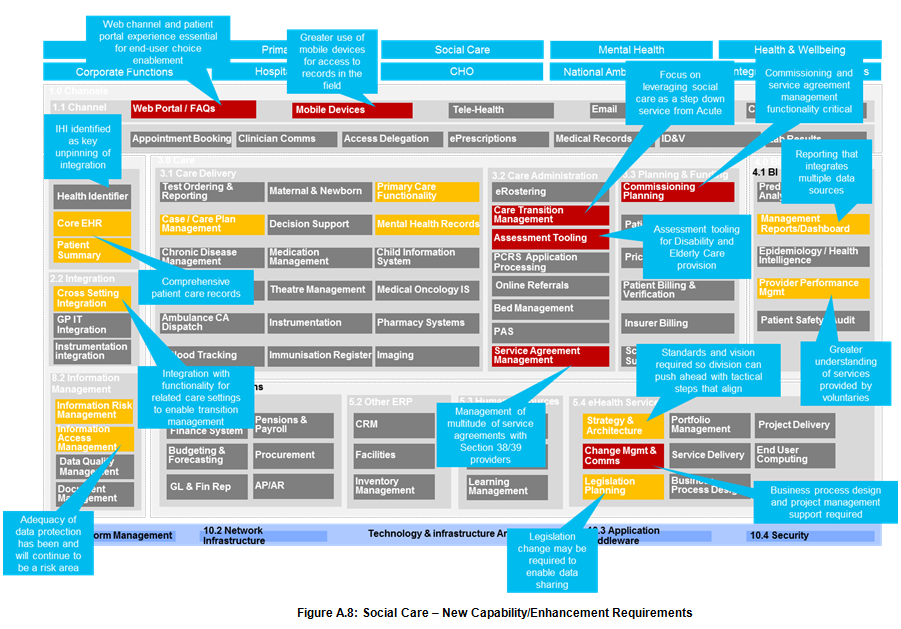
Office of the DDG / Planning and Business Information
|
Capability Priorities
|
Main Points to Note
|
|
Reporting
|
- Enterprise level monthly performance reporting is driven by the NSP2015 Accountability Framework and the balance scorecard and currently done manually
- Links between data and systems is key
- Accuracy of information is critical due to corporate level consequences
|
|
Information Management
|
- The creation of a common data dictionary and a minimum suite of standard operational (non-clinical) procedures
- Basic systemisation of information is required for management purposes
- The creation of a common minimum organisation-wide dataset that all hospitals and CHOs must present to overcome the current data gaps when assessing outcomes
- Robust document management system
|
|
Information Governance
|
- Criticality of information will require robust internal information governance to be put in place
- Additionally there may be legislative requirements that should be planned for to enable effective use and sharing of data collected
|
|
Data Collection and Collation
|
- The creation of a datamarts / data warehouse to store information to enable the complete collection of data and information from disparate sources to effectively assess outcomes and plan services – potentially building on Health Atlas capability
- The ability to collate common data from a number of different sources in an efficient and effective manner
- The ability to ensure data quality through data validation and through providing support for effective data audits
- The collection of data as close to service delivery as possible
|
|
Data Usability
|
- The end goal is for users to be able to self-explore data
- For data to be of a high quality and standardised in nature to ultimately enable data sharing in a reusable and open manner
- Health Atlas is a key platform to enable users across the health system to use data to drive decision making. Including further data sets and making the system accessible to a greater number of users is key
- Provide the predictive capabilities to support the commissioning process
- Robust knowledge management capabilities, to more fully utilise existing data
- Data to provide support for estimates and planning process
|
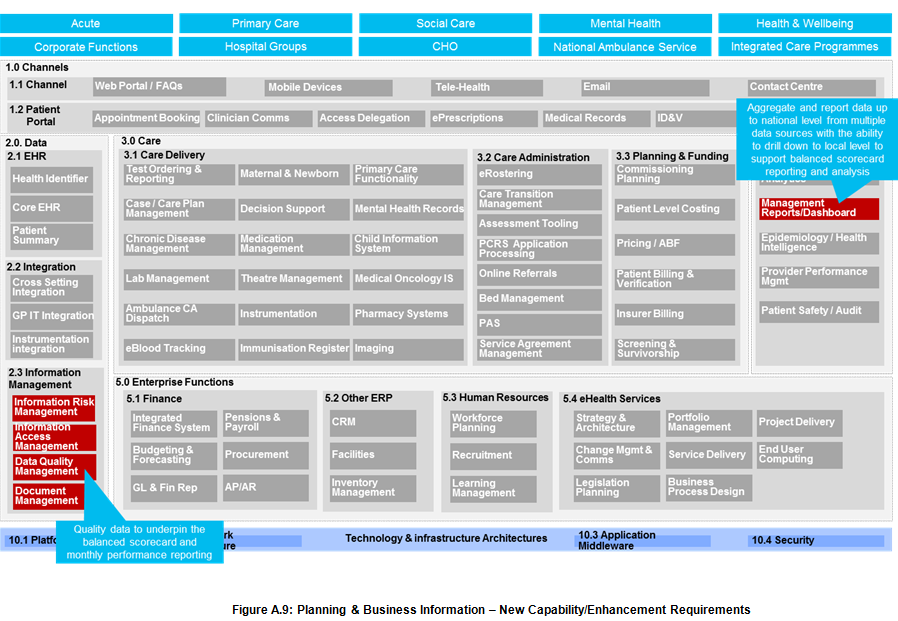
National Ambulance Service
|
Capability Priorities
|
Main Points to Note
|
|
Alternative models of care
|
- Ability to quantify urgent/emergency care to ultimately be able to relieve emergency departments and introduce alternative models of care
- The greater availability of patient information to determine the best model of care to adopt by the paramedic e.g. treat and discharge by the advanced paramedic, patient to be admitted to ED, primary care centre or alternative care setting
- Strengthening communication with and visibility of community first responders nationally including a formal structure and onboarding process and the potential for mobile applications
|
|
Availability of patient information
|
- Continued rollout of the electronic patient care record for ambulance staff to enable better patient flow and allow more effective patient handover to emergency departments and other care settings
- Introduction of a summary care record that paramedics can access remotely to determine the best treatment for a patient based on their medical history
- The electronic patient care record will also enable the NAS to audit internally
|
|
Shifting to outcome driven focus
|
- On-going move from response times to patient outcomes means that there is a greater need to be able to track patients through the hospital to determine their outcome
- Will become a far less labour intensive process through the introduction of the electronic patient care record
|
|
Move to one national service
|
- Technical and data integration necessary to create a more holistic view of the country including ambulances, community first responders and private defibrillators (e.g. GAA club and community defibrillators)
- Greater emphasis and importance placed on supporting and connecting technologies underpinning the move to a singular national service
- Technical integration necessary to support the consolidation of call centres to the Tallaght national control centre and to make the possibility of a single national out-of-hours and triage service more feasible
|
|
Enable better staff and vehicle utilisation
|
- Accurate management information to optimise the utilisation of skilled staff and resources including vehicle placement optimisation depending on trends and times
- Ensuring that all technologies contained within the ambulances can co-exist and work both independently and interdependently most effectively
- Emergency department real time tracking on visibility of incoming ambulances and wait times
|
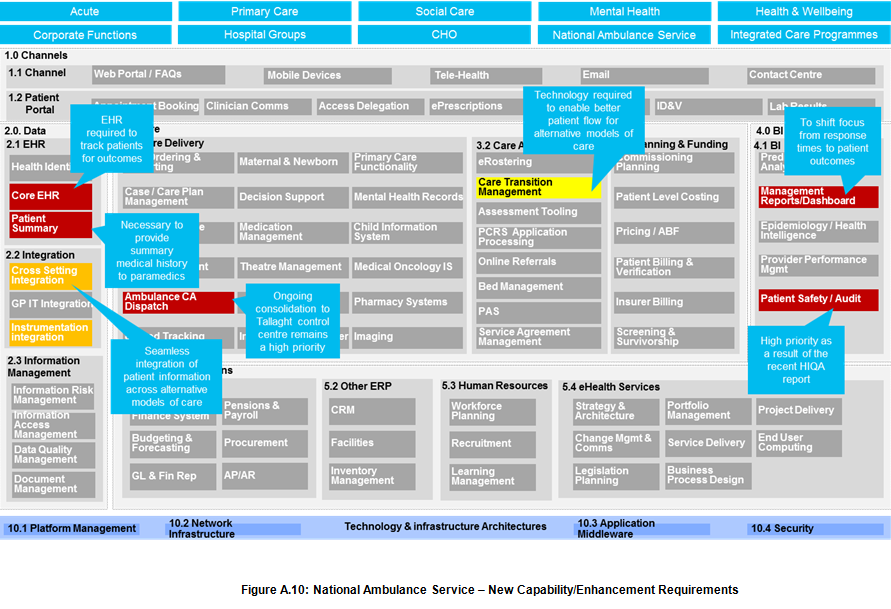
Inputs & Reviews
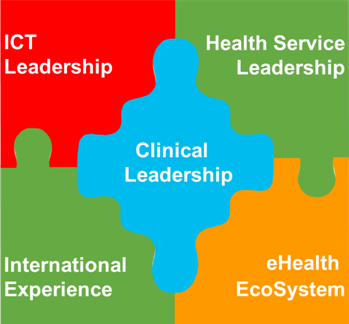
While this document aims to serve as a high level guiding strategy and roadmap, it is underpinned by a rigorous process of input and review, prioritising the need to ensure that priorities are aligned with patient needs and the views of clinicians.
This strategy was formulated over a three month period commencing at the beginning of 2015. An initial draft strategy was drafted based on the ambitions set out in the 2013 eHealth strategy published by the department of health, combined with an understanding of the priorities of HSE clinical and service leadership.
This initial strategy iterated extensively based on the feedback ideas, and robust but constructive challenges received from a wide network of contributors and reviewers.
|
Input Type
|
Nature of Input
|
|
Clinical Leadership
|
- Clinical leadership was engaged at an early point to understand how technology could underpin and support broader reform objectives.
- Clinicians engaged with include HSE leaders responsible for the delivery of patient care, clinical programme leadership and key programmes such as the National Cancer Control Programme and the HSE Quality Programme
|
|
Health Service Leadership
|
- The broader HSE leadership team were engaged with to understand both patient facing clinical needs as well as key support functions including finance, business services, patient administration and wellness activities
|
|
International Experience
|
- The strategy also reflects the successes and lessons learned from the experience of international healthcare systems who have undertaken similar transformations
- Specific input and review was sought from a number of international clinicians, researchers and other experts on the proposed strategy
|
|
ICT Leadership
|
- This strategy builds upon a complex legacy architecture and will depend on the contribution of the HSE K&I team for successful implementation. The views of ICT leadership on strengths and challenges were considered along with key programme leads (e.g. Individual Health Identifier).
- Extensive valuable input was also received from both HSE ICT staff members and ICT teams in Voluntary and Statutory Hospitals.
|
|
eHealth EcoSystem
|
- The views of a wide range of technology vendors and market analysts were sought to validate the direction and feasibility of the strategy. In particular, how future technology trends that are rapidly emerging might impact patient care delivery were explored. How this strategy impacts the local eHealth ecosystem was also considered during the review process
|











